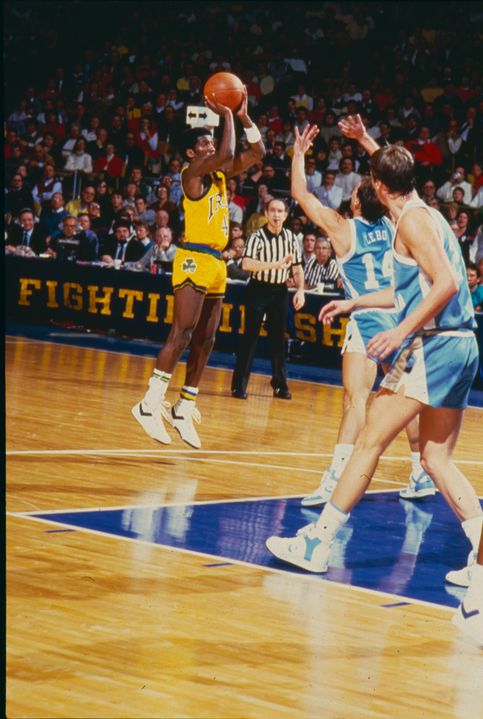Jan. 14, 2017
By John Heisler
The University of Notre Dame men’s basketball honor roll boasts a handful of familiar names who were four-year standouts in an Irish uniform.
Rich Branning and Kelly Tripucka had been the only players to score in double figures in four straight seasons until dazzling 6-0 point guard David Rivers showed up in South Bend (since then LaPhonso Ellis, David Graves, Pat Garrity, Chris Thomas and Luke Harangody have done it)-yet no one did it at Rivers’ level.
Rivers is the only player in Notre Dame history to average at least 15 points per game in four consecutive seasons. He became the first Irish player to lead the team in scoring four straight years (only Garrity has accomplished that since then).
Yet numbers barely scratched the surface of the Rivers saga in South Bend.
The best player to wear a uniform in Digger Phelps’ 20 seasons as Irish head coach? Phelps says it’s Rivers-and that’s saying something considering Phelps’ rosters also contained glossy names from John Shumate, Gary Brokaw and Adrian Dantley to John Paxson and Tripucka.
That sort of consistent productivity came because Phelps handed the keys to the Irish offense to Rivers the moment he stepped on campus. That hardly counts the electricity the Jersey City, New Jersey, product injected into the Athletic and Convocation Center.
Yet, as much as anything, that night-after-night production is why Rivers Saturday becomes the fifth Irish player to join the Ring of Honor.
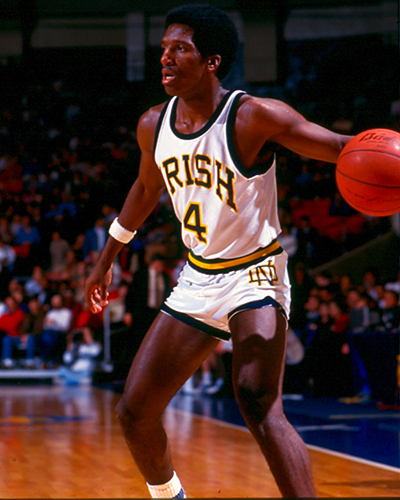
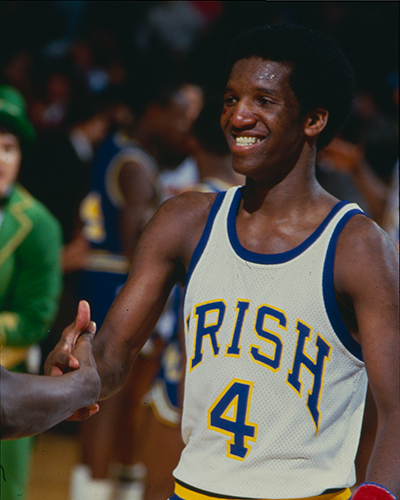
Rivers’ freshman season debut in 1984-85 came in a public intra-squad scrimmage-he hit 11 of 16 shots and finished with 25 points and nine assists.
Wrote The Observer, the Notre Dame student newspaper, “If the play of Rivers last night was any indication of what this season holds for Notre Dame fans in terms of excitement . . . a sedative might have to become a pregame ritual to prevent hyperactivity.”
Offered Phelps, “The key to our success is getting 13 players to play with David Rivers.”
A few days later he scored 19 in an easy win over the Yugoslavian club team Zadar.
His official regular-season debut produced 14 points in a home victory over Manhattan.
After an early-season triumph over Northwestern, Wildcat coach Rich Falk said Rivers has the “court sense that a Magic Johnson or an Isiah Thomas has.”
But he opened lots more eyes in Notre Dame’s 11-point home win over 11 th-ranked Indiana when he led both teams with 23 points, 16 in the first half, and five assists (on a night the Irish limited Steve Alford to four points). He proved the catalyst in a 20-2 Irish run.
“He’s got a green light to go,” said Phelps. “We love him with the ball.”
Wrote Phil Hersh in the Chicago Tribune, “He has made an elemental transformation in Notre Dame basketball, turning it from lead to mercury.”
Bill Benner of the Indianapolis Star called him “a gem of a point guard just waiting to be polished.”
The headline on one South Bend Tribune column by Bill Moor read, “Digger Phelps knows he can’t lecture a bullet.”
Said Phelps, unapologetically, “David does things with the ball I’ve never seen before.”
As a rookie Rivers led the Irish to 21 wins and a 1985 NCAA Championship victory over Oregon State. He averaged 15.8 points per game, most by a Notre Dame freshman other than Dantley’s 18.3-and good enough to earn him College Freshman of the Year honors from Basketball Weekly. He won a game against Marquette by dashing the length of the court and hitting a 12-foot baseline jumper as time expired to defeat the Warriors by a point in Milwaukee. He had 16 points in a matchup with Syracuse’s Pearl Washington and dazzled to end the year with 16-of-26 shooting in his two NCAA appearances. As a sophomore he had five straight 20-plus-point games, including 28 versus BYU.
Next came the 1986-87 campaign, Rivers’ third at Notre Dame. Little did he, Phelps or anyone else connected with Irish basketball know its beginning would be completely against the grain.
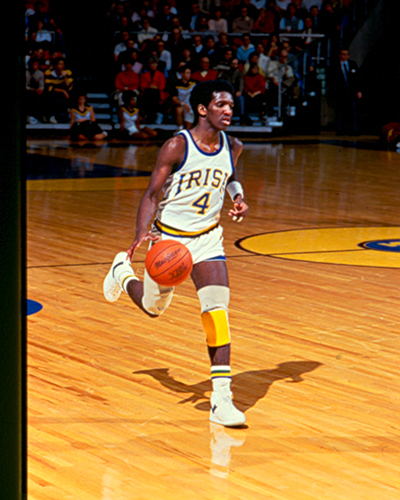
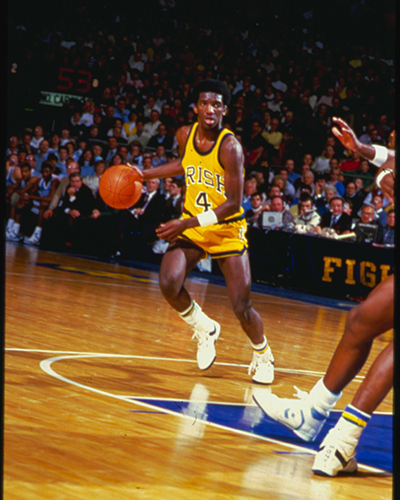
Phelps’ home phone rang about three in the morning on a late August Sunday.
On the other end of the line was Skip Meyer, the Irish basketball trainer, with news that Rivers and teammate Ken Barlow had been involved in a van accident about a half-hour southeast of town. Barlow was fine, but Rivers had been thrown from the vehicle (through the windshield) and had a 15-inch cut across his abdomen that left him in intensive care after three hours of surgery.
Suddenly basketball became the lowest of priorities.
Yet Rivers’ subsequent recovery and rehabilitation proved remarkable. He returned to classes by mid-September, began riding a stationary bike, spent hours jogging in four feet of water in the ACC pool and by Nov. 1 began shooting jump shots. Miraculously he was back to full speed at practice by Nov. 16 and he came of the bench to play 34 minutes and score eight points in Notre Dame’s season opener against Western Kentucky.
That comeback earned him the Most Courageous Athlete Award from the U.S. Basketball Writers Association. Sports Illustrated profiled the recovery, and Rivers appeared with Bryant Gumbel on a Today Show segment.
Rivers scored 14 second-half points to help his team knock off top-rated North Carolina 60-58 in February and later led the Irish to NCAA wins over Middle Tennessee State and TCU.
“We designed a special play for that North Carolina game based on David’s creativity and where Gary Voce wanted to shoot the ball,” says Phelps. “David comes off a pick and roll on the right, so J.R. Reid has to come off Voce to get Rivers. Voce would step back to take that shot and ended up with 15 points (hitting five of seven field goal attempts). David made that play our bread and butter that day. He just made things happen.”
Recalls former Irish assistant coach Jeff Nix (now assistant general manager of the NBA Detroit Pistons), “I remember the first day I met David in the basketball locker room. David was recovering from his auto accident when we were first introduced, and he was getting dressed in the locker room when I saw the scar across his stomach area.
“Not only was David an inspiration for many on the court due to his recovery and ability to play at a high level, but from that first meeting I will not drive 10 feet in an automobile without putting on my seatbelt. That simple and seemingly insignificant introduction changed my life and others who ride in a vehicle with me because I make certain seat belts are utilized at all times.”
One of 14 children in his family, Rivers was no stranger to tough stuff. When he was 9 his 19-year-old brother Willie was stabbed to death. A month and a half later 20-year-old brother Joseph was killed by a speeding truck. During his rookie season with the Los Angeles Lakers, Rivers’ younger brother Jermaine succumbed to an inoperable brain tumor.
Somehow a cut along his stomach seemed minimal in comparison.
“I never got a chance to say goodbye to any of my brothers,” said Rivers.
“He may be the toughest player I have ever been around,” says former Irish assistant Matt Kilcullen, now director of athletics at Mercy College in New York.
A long-time star playing professionally overseas, Rivers went on to run a series of camps as well as a program to place European players after their basketball careers ended. Rivers’ son Sebastian is now a freshman at Holy Cross College in South Bend.
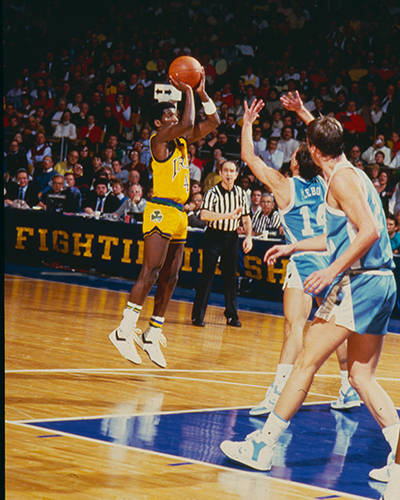
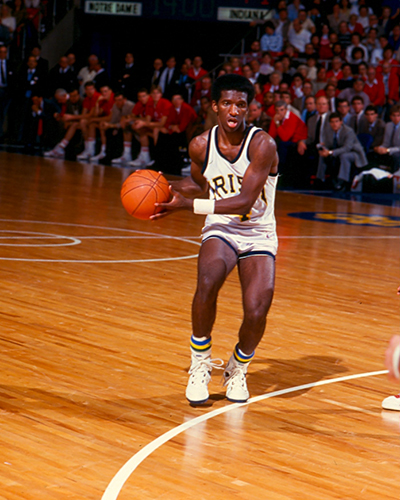
Phelps recalls visiting Rivers at the home of legendary St. Anthony’s High School coach Bob Hurley.
“When Pete Gillen left Villanova to come here as an assistant, his East Coast background really helped because he knew Bob.
“What’s funny is that when we were there there were two little kids sitting on the couch, maybe seventh- or eighth-graders-with David going into his senior year at St. Anthony’s. Those two kids were Bobby and Danny Hurley who went on to be great players at Duke and Seton Hall. (Bobby is now head coach at Arizona State and Danny is head coach at Rhode Island.)
“We were battling all the Big East schools, but David was really receptive because he knew the New Jersey connection with Notre Dame (John Shumate, Gary Brokaw, Bill Paterno, Kelly Tripucka) and he wanted to be the first person in his family to earn a college degree. He had to work extra hard to make it happen academically, but he knew that and he graduated on time with his class at Notre Dame.”
Nearly three decades later Phelps pays him the ultimate compliment:
“People ask me who the best player is that I ever coached. It’s David Rivers because when he dribbled the ball he knew what nine guys were doing. If he took one more dribble the defense would shift a foot and he’d throw a pass in that gap.”
Rivers ended as Notre Dame’s career assist leader–and only Austin Carr and Dantley had scored more career points at the time Rivers finished in South Bend.
Says Brokaw, a former Irish assistant coach during Rivers’ time in South Bend, “David for me was the best playmaker the University has ever seen. Others could put on a show at clinics, camps, events or playgrounds, but David would do that in practices and games. He made others better, even though, on many occasions, a lot of his big men couldn’t catch his targeted passes.
“Johnny Dawkins and Kevin Johnson were the quickness players I’ve ever seen going foul line to foul line with the ball. Pistol Pete (Maravich) and Earl Monroe were the best ball-handlers I played against. But David in college, going top of the key to top of the key, was the best at being able to handle the ball and make a play.
“I remember watching the late Pearl Washington play in high school, and I told some NBA scouts I would pay money to watch the Pearl play. Well, David was better, and I appreciated his play, work ethic and humility as much as any player that I have ever been associated with.”
Phelps loved that ability to create whatever was required.
“In his first scrimmage David hit Tim Kempton in the face because he (Kempton) didn’t know what was coming. David would stare at you because he’d lost a chance for an assist.
“That’s how he was as a player-very creative. He knew what defenses were doing and how to challenge those defenses.”
Senior associate athletics director John Heisler has been covering the Irish sports scene since 1978.







